
Brad Gooch’s Rumi: Unseen Poems, edited and translated with Maryam Mortaz, is published this month. He shares five books of spiritual poetry.
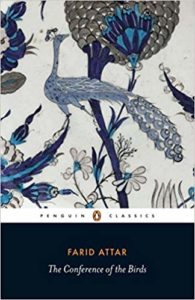
The Conference of the Birds by Farid Attar (trans. Afkham Darbandi and Dick Davis)
An exquisite perk of my deep dive into classical Persian poetry in search of Rumi has been Attar, the 12th-century poet whose sly renderings of Sufi thought into verse was a great influence on him. As transcendent as Dante, even edgier than Chaucer, Attar’s tale of thirty birds seeking the divine bird Simorgh only to wind up confronting a divine mirror in which they see their own reflections soars. As in most cases involving translating Persian poetry, Dick Davis soars, too.
Jane Ciabattari: Attar’s classic text opens with the “leader” of the conference of birds, the hoopee:
Dear hoopee, welcome!
You will be our guide; It was on you King Solomon relied
To carry secret messages between His court and distant Sheba’s lovely
queen. He knew your language and you knew his heart –
As his close confidant you learnt the art Of holding demons captive
underground, And for these valiant exploits you were crowned.
How does the hoopee moderate the conference?
Brad Gooch: One of the many tricks of translating medieval Persian poetry is the total absence of punctuation, including quotation marks. Attar used this wide-open space to his advantage. Often while reading this rambling poem you can’t tell whether you’re hearing the voice of the poet or his hoopee, a teeny bird with a mohawk of colorful feathers. Both are wise and very sure of themselves. (To the delight—or exasperation—of translators, Rumi was fond of another challenge hard-wired into the circuitry of Persian: the third-person pronoun may refer to he, she, it, or God. Is the poem to a man, a woman, or God? Rumi’s poetry is the Wimbledon of this nimble game.)
In “The Conference of the Birds” the hoopee plays the part of a caravan leader of a flock of birds flying through the heavens, while behaving like a Sufi sheikh, though without dark blue robes or a winding turban. He gets his points across by telling tales with morals often as perplexing as Zen koans. He is a cosmic GPS as he encourages the winged souls on a pilgrimage through the seven valleys of the Way, from the first Valley of the Quest to the final Valley of Nothingness. The holy grail turns out to be a pun: thirty birds make it all the way, and the name of the divine shimmer they are seeking—Simorgh, a phoenix popular in Iranian mythology—breaks down into si-morgh, meaning thirty birds. My favorite scholar of all things Persian and Sufi (and Arabic and Islam), Anne Marie Schimmel deemed this “the most ingenious pun in Persian literature.” I feel sure the clever pun occurred to Attar before writing the poem rather than the other way around.
Spiritual poetry in the medieval era is always expressing a religious tradition, no matter how extreme or with however much transcendence. The notion of being spiritual without being religious would not have computed for either Attar or Rumi. They were putting Islam into song and story—Sufi Islam, the mystical branch of the religion, stressing God’s intimacy rather than authority, and love over fear. Many of the tales the hoopee unspools are shocking: a pious Muslim sheikh falls in love with a Christian lady and converts to her faith; pilgrims on the way to Mecca insult God. Several of the passionate love stories are between men. The poem builds towards a Sufi message of atomization in love and discovering God within: “I am a mirror set before your eyes/And all who come before my splendor see/Themselves, their own unique reality.” Yet it’s the transgressive tunes of scandal sung by the hoopee that make it ever readable.
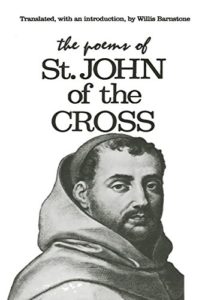
“The Dark Night of the Soul” by St. John of the Cross. (trans. Willis Barnstone)
This sixteenth-century verse by a Spanish saint was the standout poem of my teenage years. I used to have dreams of wandering in the dark night tailored to its verses. I suppose the traditional Catholic imagery dipped in pain and blackness appealed to me as to some punk rockers of my era, such as Patti Smith. Now, more obvious is the allure to the teen me of the poem’s eroticism, even homoeroticism, folded into its theology of the soul entwined with its nocturnal beloved: “In the breeze from the ramparts/ I parted his locks. /He wounded my neck/ With his gentle hand.”
JC: That combination of spirituality and sexuality also influenced other poets, including Hart Crane and Robert Lowell. How did the poet create such a powerful effect?
BG: The poems of St. John of the Cross are a spiritual aphrodisiac. Their perfume is a potent mix of darkness, secrecy–a love-starved poet with a pounding heart, and fingers caressing long hair. No one except San Juan’s dear friend Theresa of Avila was ever such an erotic soul—she who reported being pierced through her heart by the flaming arrows of an angel. I was brought up in a secular, lazily atheist sixties suburban ranch house. My rebellion was to seek out religion on my own. I came forward at a screening of a Billy Graham film, “The Cross and the Switchblade,” as mesmerized by the switchblade as the cross, since the timing of my juvenile awakening was synchronized with my puberty. I sensed some similar wires crossed in St. John. Willis Barnstone was the translator of the verses I read then, and so they remain burned in my brain. Only once was I tempted to stray, when David Plante, in a volume of contemporary writers on the saints, A Tremor of Bliss, dared his own translation of “Dark Night.” His last stanza was even more swoon-worthy than Barnstone’s: “There I remained, lost to myself. / I pressed my face to the one I loved. / All stopped, and I / Gave myself up, / My pain no longer pain /Among the lilies.”
As you say, St. John of the Cross—and the writings of medieval Catholic saints—experienced an uptick in the last, the modern century. C.G. Jung borrowed Saint John’s drama of the dark night of the soul and psychologized it. Hart Crane was nearly a medieval saint-poet in drag in his “Lacrymae Christi.” Only the clotted language gives him away as more Gerard Manley Hopkins—”unmangled target smile”—than Saint John, whose fire and lilies are as simple and vivid as story elements set in stained glass. Robert Lowell, convert to (medieval) Catholicism, and friend of the Thomist Jacques Maritain, felt free enough to parody “Dark Night” in “Skunk Hour:” “One dark night, /My Tudor Ford climbed the hill’s skull; /I watched for love-cars. Lights turned down, / they lay together, hull to hull, /where the graveyard shelves on the town…. /My mind’s not right.” Yet none of them seem as shock-to-the system modern as Saint John.
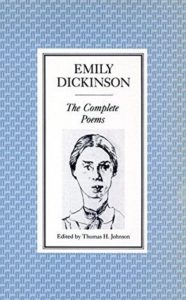
Emily Dickinson’s Poems
Emily Dickinson’s “letter to the world,” as she describes all of her poems taken together, reads like a single work inflected with her taut spirit and an ecstatic response to life, which she recognizes as a sensation that causes her to feel “physically as if the top of my head were taken off.” Dickinson is the first modern mystical poet to skip religion and belief: “Some keep the Sabbath going to church/I keep it staying home.” She is a nun cloistered within high language.
JC: Which of Emily Dickinson’s phrases most move you?
BG: “Who is she taking dictation from? Poetry itself??” I’d say that is a decent approximation of the felt question that runs through my brain—like the funeral that kept “Treading—treading” in Dickinson’s—whenever I trip across a line of hers that sounds like no line ever written and no combination of words ever so combined and no thought ever quite had. I recall this sensation once upon a time with lines so famous they’ve become—if any Dickinson line can—familiar: “I dwell in possibility” or “After great pain, a formal feeling comes.” Yet mulling an answer to your question, I noted new ones that I’d either forgotten or blurred, which elicit the same reliable tingle: “That polar privacy/A soul admitted to itself/Finite infinity” or “the quiet nonchalance of death.” For poems rather than just phrases, I return to those setting new words to old hymns, climbing then letting go of the ladder of church doctrine, as in the poem “My period had come for Prayer” that cantilevers its way to ecstasy—a state identical for her with writing a poem:
Creation stopped—for Me—
But awed beyond my errand—
I worshipped—did not “pray”—
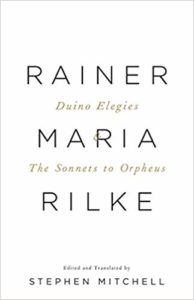
Duino Elegies by Rainer Maria Rilke (trans. Stephen Mitchell)
I remember where I was when I first read those shocker opening lines—in the kitchen of my fundamentalist aunt, where my family had taken shelter after our house was washed away in a flood: “Who, if I cried out, would hear me among the angel’s hierarchies?” To write a poem aware of the p.o.v. of the angels was a device hiding in plain sight within lyric poetry for centuries, brilliant enough to then be borrowed by Wim Wenders in Wings of Desire. Rilke was full of romantic ache for his terrifying angels. They were who he longed to be when he grew up.
JC: That’s a dramatic story. The flood. Discovering Rilke. And I love his line, “…beauty is nothing but the beginning of terror.” How has Rilke influenced your own work?
BG: My reading of those vaunting lines occurred not only after a flood (caused by Hurricane Agnes, 1972) but also after a year of writing poems in Kenneth Koch’s “Imaginative Writing” seminar at Columbia College. I gulped down the New York School Kool-Aid as I was introduced to a fresh canon of poets I had barely known, if at all: Rimbaud, Mayakovsky, Pound & Williams. Curly-haired Kenneth, in his fluffy burgundy sweater, the only English professor not in a suit, clearly had opinions. He only liked the young works of poets who later turned more metaphysical: young Stevens, young Auden. In his genius poem “Fresh Air,” he put down “Eliot of the baleful influence” for being too stuffy. I don’t remember him ever commenting on “Duino Elegies,” but we read instead Rilke’s early zoo poems about the panther or the flamingos. He then had us write our own imitations. Mine was a poem about a painting in the Museum of Modern Art that loved being gazed upon. Kenneth praised its unabashed (unaware?) narcissism. And suddenly here I was, childhood home washed away, entranced by a poem deeply exalted. Who knows? Kenneth may have loved “Duino Elegies,” but I took it as a sign I might need to think for myself. I can’t say (unlike the flamingos’ poem) I ever dared doing my own version.
As for influence on my work—to be more up to date—Rilke led me on a zigzag path to Rumi. Astonishing to me was Rilke figuring out—or as he might put it, being singled out from on high—how to write poetry about souls, angels, and God that was strong, original, and free of treacly cant or clichés. Of course, he was a free agent. I admired Flannery O’Connor (of whom I also wrote a biography) perhaps even more for pulling off dark, brilliant stories that she at least felt were inspired by Roman Catholic theology without tipping into catechism. Rumi is another such rarity: a world-class writer of mystical poetry whose works can thrill with or without sharing his entire belief system. Of the three, Rilke and Rumi feel most akin, in their wild freedom, their longing for an elusive beloved, their habit of marrying the whole world. Perhaps I should have paid more attention to one clue early on—of his angels, Rilke wrote to a friend, “The ‘angel’ of the Elegies has nothing to do with the angel of the Christian heaven (it has more in common with the angel figures of Islam.)” If I had to identify these beautiful, terrifying Rumi lines on a quiz, I might almost—or as Flannery O’Connor wrote, “with one eye squinted”—identify them as Rilke:
One morning, a moon appeared in the dawn sky
Descending even closer to get a look at me
Like a hawk, seizing a little bird, while hunting,
That moon seized me, and as we climbed the sky
I looked within myself, only to find no self there
Within that tender moon, my body had become a soul…
The entire ship of my existence had vanished in the sea.
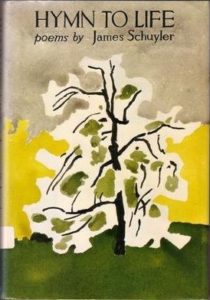
Hymn to Life by James Schuyler
Schuyler is a poet of the everyday, who makes the everyday feel weirdly luminous and transcendent, the residue of classical mystic poetry. Especially in his longer, later, lackadaisically meditative poems, such as “The Crystal Lithium” or, my favorite, “Hymn to Life,” diaries and hymns are as one. His urban garden is not exactly Rumi’s rose garden, yet, as he writes, while effusing over lilacs, “Persia, we/Have so much to thank you for, beside the word lapiz lazuli!”
JC: How might you compare Schuyler to Rumi?
BG: I confess, putting Rumi and James Schuyler in the same sentence is a stretch. Schuyler loved real flowers (not the stock roses and narcissi of Persian poetry) and knew how his garden grew. He reveled in putting all the trivial pratfalls of daily life into his gossipy poems. He had a sense of humor. Yet in the silence between the lines, I often felt Schuyler was—if certainly not our Rumi at least perhaps our Thomas Traherne, his ecstasy triggered by honeybees or dappled waters. As with many subtleties of modern American poetry, Helen Vendler articulated it best in a review in the 1980s: “There are references to antidepressants, drinking, Antabuse, A.A. And yet, in spite of the bad biological hand that has been dealt him, Schuyler exhibits, especially in the long poems, a sunflower-like turning to life—a life hardly, it would seem, livable, but one represented often as ecstatic.” Like Dickinson and Rumi, Schuyler (same poem) took his spirituality clean, without religion: “Times when religion would help…But without the conviction of a truth, best leave/it alone.” Schuyler’s personal bipolar sort of ecstasy was best expressed in his “Payne Whitney Poems,” which are “a real trip,” as we used to say. In one of them. “What,” written while admitted to the psychiatric hospital, I feel he outs his inner medieval saint: “The daffodils, the heather/ and the fresias all/speak to me, I speak/back, like St. Francis/and the wolf of Gubbio.”
*
· Previous entries in this series ·

